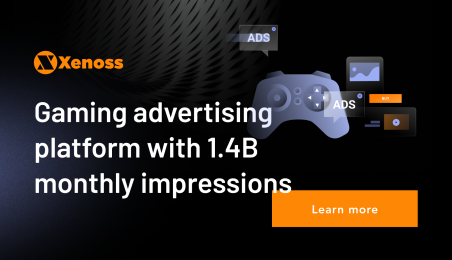Connected TV (CTV) is an ad channel you can’t ignore: 46% of US consumers watch content on connected devices daily. With every major broadcaster launching over-the-top (OTT) offerings and independent players multiplying, the CTV advertising market is getting critical traction.
CTV ad spending is set to increase from $14.11 billion in 2022 to $18.29 billion in 2024. As Netflix and Disney+ (among many others) launch ad-supported tiers, ad inventory will also grow in volume.
However, media buyers have mixed feelings about CTV advertising. Colgate-Palmolive increased its ad reach by 58% and drove down the over-supply of linear TV ads with the help of CTV advertising. At the same time, over $1 billion in ad budgets are wasted on running ads when the CTV sets are off.
Generally, CTV advertising is perceived as difficult to measure. However, connected TV ads can provide data points equal in relevance to other digital channels with a proactive approach to partnerships and interoperability.
In this post, you’ll learn about:
- The fragmented CTV market landscape and its implication for AdTech companies
- The main challenges of CTV advertising measurement and attribution
- Best tech practices for gaining CTV measurement data buyers need
CTV market overview: Platforms & operating systems (OS)
The CTV market is an ecosystem. Participants include smart TV device manufacturers, standalone media players, OTT providers, and content distribution platforms. All of them have a heavy hand in the market because they own (but do not always share) consumer data.
To gain full visibility into CTV ad performance, ad platforms have to integrate data from multiple sources. What makes CTV measurement even harder is that no single player dominates the smart TV OS market or the OTT market.
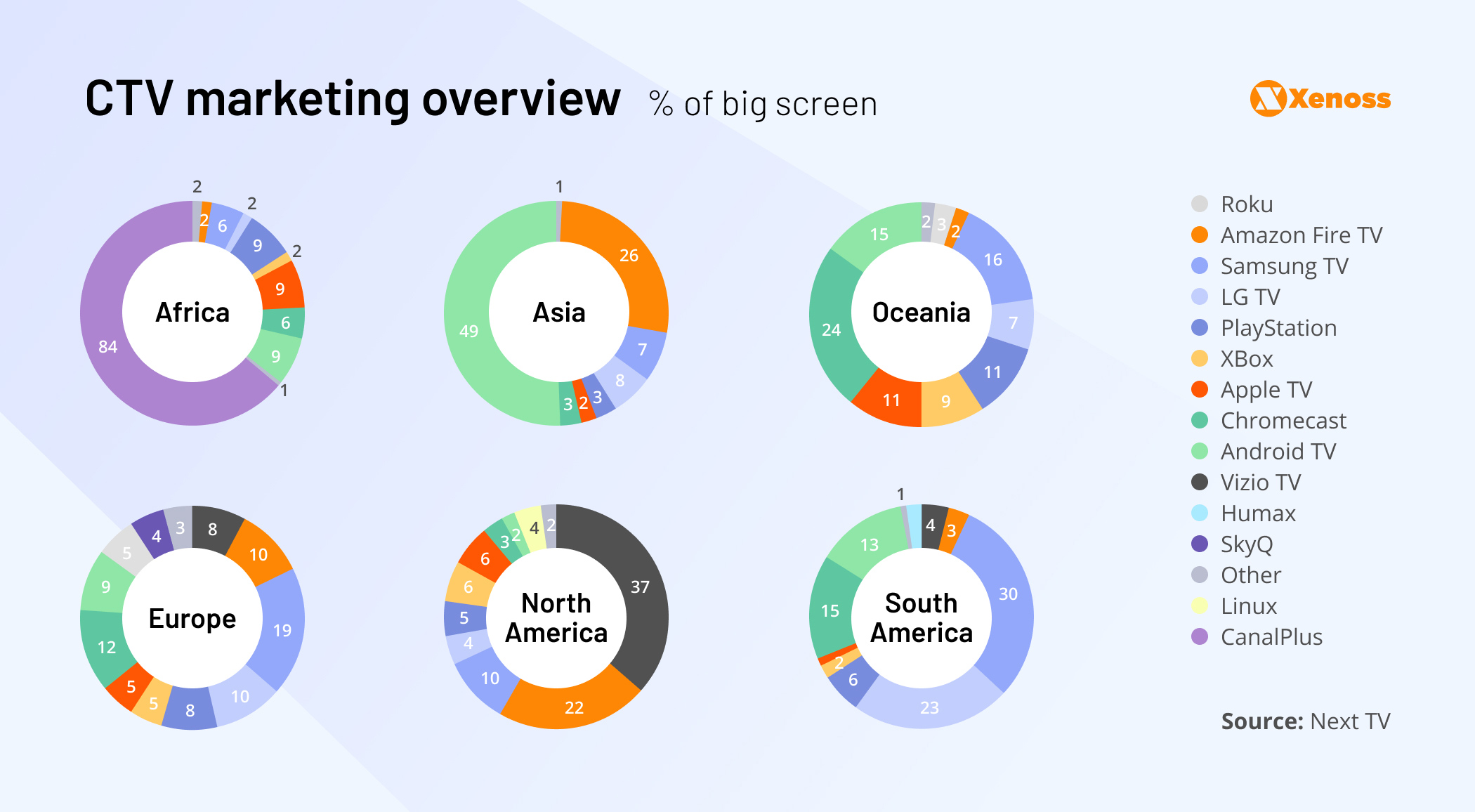
Main types of CTV players
- Smart TVs with native OS (e.g., Samsung TV, LG TV, Sony, Vizio with embedded Chromecast)
- Stand-alone streaming devices and media players ( e.g., Roku, Amazon Fire, Chromecast, or Apple TV)
- OTT video-streaming services (e.g., AT&T TV, HBO Max, Hulu, Netflix, Paramount+, Rakuten TV, etc.)
- Content distribution platforms (e.g., Amagi, Castify.ai, BitCentral, Viaccess-Orca, etc.)
That said, the global CTV market has its “big four” players, holding most of the audience data (and advertising dollars).
Samsung Connected TV

Samsung was among the first to release competitively priced smart TV sets. As of 2020, some 162.3 million in-use Samsung Tizen devices sit in consumers’ homes worldwide.
On a global scale, Samsung is well ahead of the competition. LG webOS only holds 7.3% of the global market, followed by Amazon Fire OS with 6.4%, and Roku TV OS with 6.4%. However, Samsung lost its dominant status in the North American markets where Roku and Amazon took over.
Roku
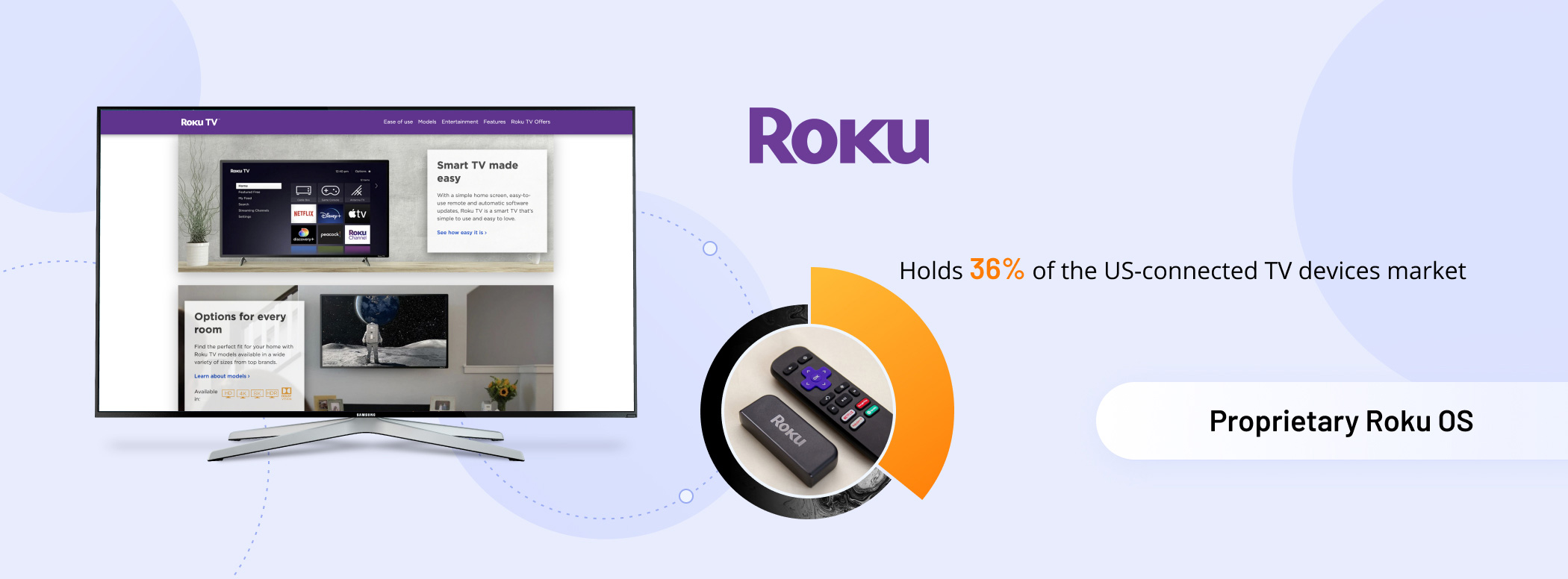
The first Roku streaming device was released with Netflix in 2008. Since then, the company expanded its hardware product range, developed a companion Roku OS, and launched a programmatic CTV advertising network.
As of 2021, Roku has 61 million active monthly users in the US, which makes them an attractive platform for OLV advertising. Per Digiday, the average spend among returning Roku advertisers increased by 50% YoY — and the platform retains 96% of the advertisers that spent at least $1 million with them. Clearly, the ROAS is there.
Yet, Roku has been continuously struggling with hardware supply issues, and its market presence outside the US remains low.
Amazon Fire TV
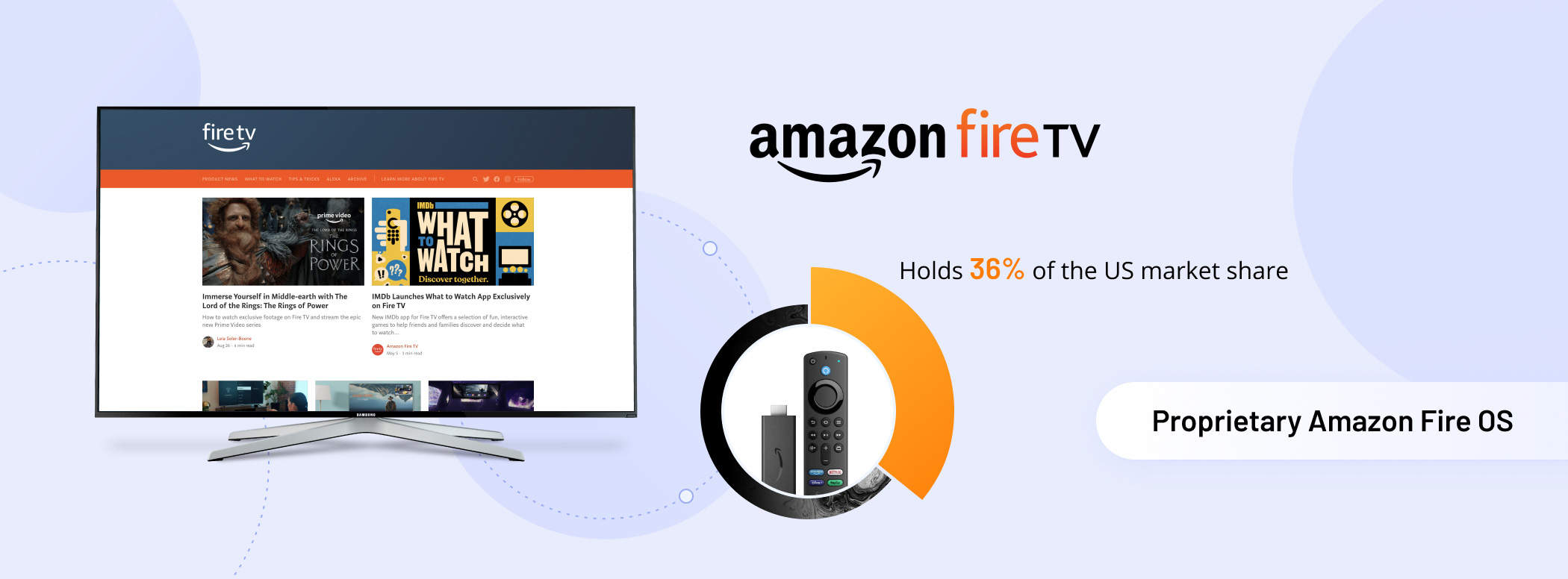
Amazon entered the CTV space with affordable Fire sticks. Later it launched Fire TV (an edition of smart television sets) plus signed Fire OS distribution deals with popular device manufacturers (Insignia, Toshiba, JVC, and Grundig). In 2022, Amazon sold 150 million new Fire TV devices worldwide.
For the past six years, Amazon has been eroding Roku’s US market share, and now they are going head-to-head in the race. As of 2021, Amazon Fire has 50+ million monthly active users in the US.
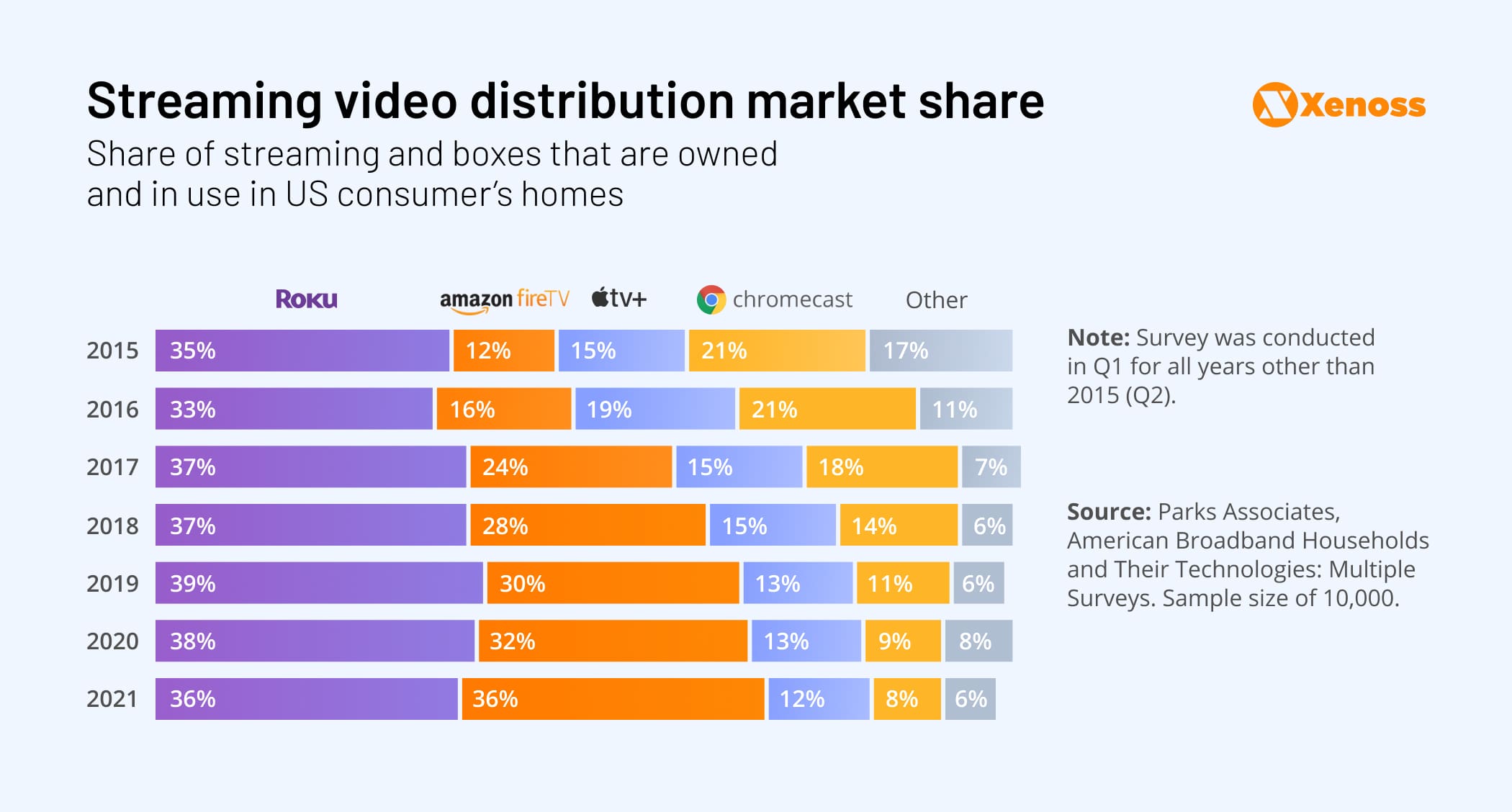
The tide may soon change as Amazon eyes the emerging in-car video streaming market. In 2022, Amazon signed a deal with Ford Motor Co. to embed Fire TV OS in 2022 models. Separately, Amazon partnered up with Stellantis auto-conglomerate to become their exclusive OS distributor.
Separately, the Amazon Prime Video streaming service (available with Fire TV) also keeps onboarding customers. It’s now present in 45% of U.S. internet households, and globally, Amazon Prime Video has 252 million subscribers. Stirring multiple pots, Amazon is a powerhouse player in the CTV advertising market.
Google TV (Android TV)
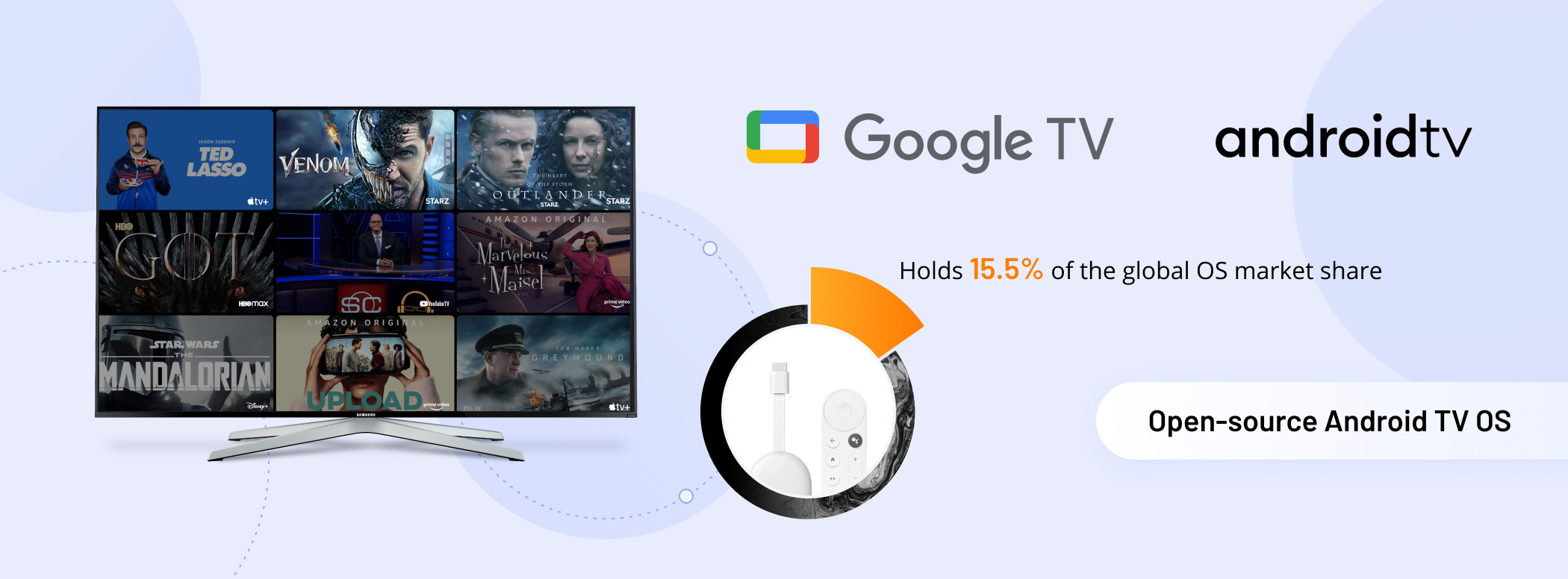
Google entered the connected TV space with Chromecast devices (smart TV sticks), but quickly assembled a larger ecosystem of products. Android TV platform is the original Google OS for smart TV sets.
In 2020, Google released a major upgrade to Android TV and rebranded its offering as Google TV. At its core, Google TV is a new interface running on top of the original Android TV OS. It comes pre-installed with new Chromecast devices and will now be the primary interface for smart TV manufacturers that opted for Android TV OS.
Shalina Govil-Pai, VP of Android TV and Google TV, said that Google’s objective is to progressively phase out Android TV and make all third-party users shift to Google TV.
Android TV (now Google TV) already comes pre-installed on smart TVs from brands like TCL, Sony, Hisense, Sharp, Philips, and others. As of 2022, Google has 110 million active monthly devices globally, which puts them close to Samsung.
What CTV market fragmentation means for the AdTech Industry
Device and data fragmentation is the bane of all new channels like in-game advertising or DOOH. Sourcing data from multiple smart TV sets, OTT providers, and OS is technically complex. In addition to many conflicting requirements and limitations is a lack of standardization. Combined, these factors complicate CTV ad measurement.
On the other hand, as Tal Chalozin, CTO and Co-Founder at Innovid, an independant CTV measurement platform, rightfully noted:
Fragmentation means competition, and competition means lower prices. When platforms have to compete against one another to secure ad dollars, then the number one lever available to them is their price. As long as the connected TV space remains heavily fragmented, marketers will benefit from a buyer’s market.
More advertisers consider CTV advertising. AdTech companies that can develop better CTV ad measurement solutions and provide precise attribution metrics will emerge on top.
CTV advertising measurement challenges
CTV attribution is hard primarily due to the absence of shared standards for measurability.
Back in the day, Nielsen pioneered measurement for linear TV advertising. Though the company made a tentative move into CTV measurement, both of its frameworks are often criticized for inaccurate audience counts.
Brands (and their agency partners) are on the hunt for a better measurement solution. Which one will it be? The following could resolve the following CTV measurement and attribution issues.
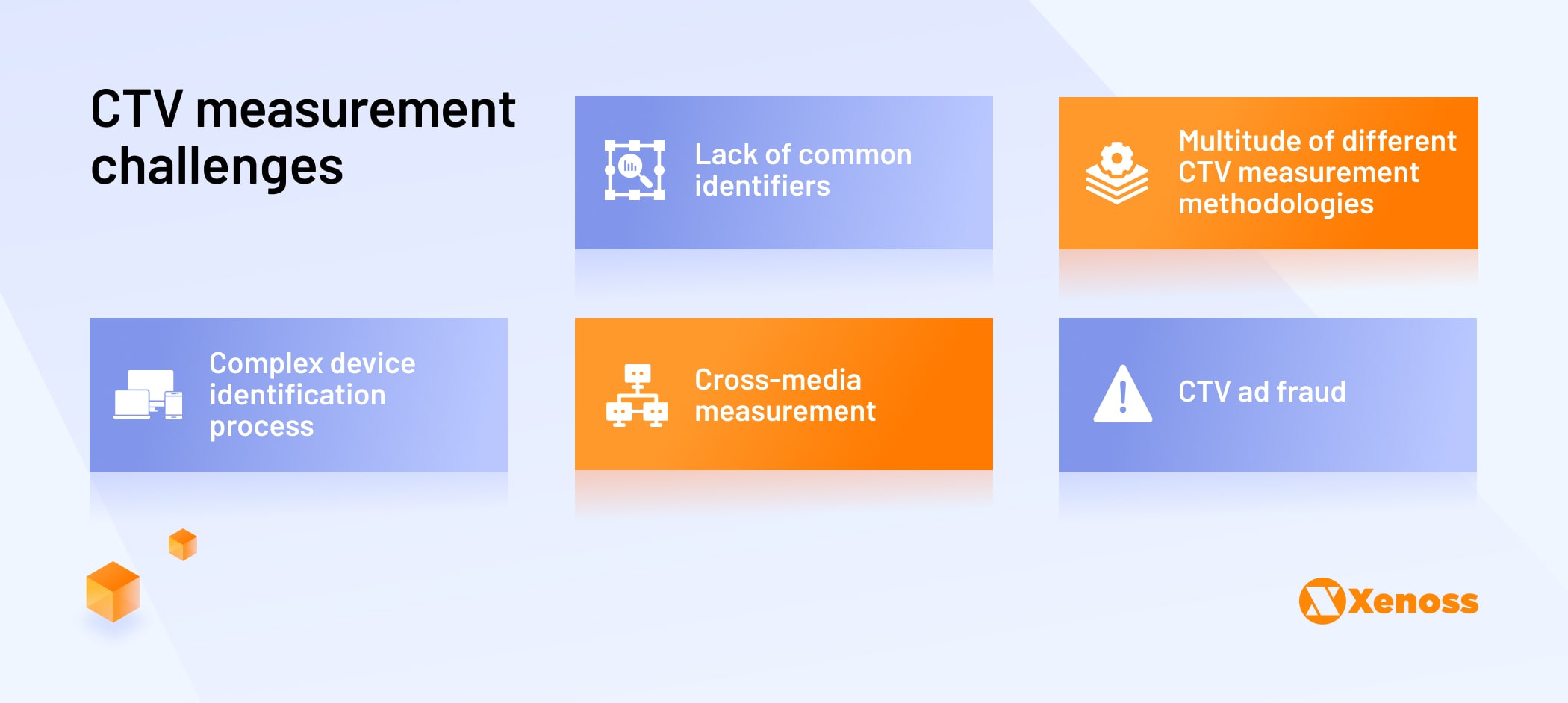
Lack of common identifiers
The digital advertising space relied on third-party cookies for years to identify, track, and report user behaviors. Now the industry works towards universally acceptable cookieless tracking and shared user ID solutions.
CTV ad space faces a similar dilemma: It needs cross-platform identifiers. IP addresses have been the most common means of identifying households as they are easy to capture. Most programmatic CTV advertising uses IP addresses for targeting and remarketing.
But is an IP address a reliable ID? No. Many consumers share streaming accounts and use various devices to view the content (i.e., the IP address changes, but the user stays the same or vice versa). Because neither supply-side platforms (SSPs) nor demand-side platforms (DSPs) can precisely ID users, a lot of budgets are wasted. For example, if a brand buys connected TV ads through Roku and via a DSP platform, they risk marketing ad duplication. According to the Innovid x ANA Report:
The average publisher duplication rate for CTV ads is 32%. Also, the average ad frequency was 6.4 across all campaigns, meaning 14% of households were exposed to the same ad 3-9 times on average.
So what are the good options? CTV-specific user identity graphs may help. Digital ID providers like Ramp ID (former IdentityLink) and Tapad recently added connected TV to their omnichannel identity graphs. However, both solutions still primarily rely on IP addresses for initial user identification. Then they augment the created identity with other data points.
An IP-based approach to user IDs wasn’t a problem…until recently. As part of the Privacy Sandbox, Google released a proposal called Gnatcatcher. Its premise: disguise people’s IP addresses as these are considered personally identifiable information (PII) under the California Consumer Privacy Act (CCPA) and European GDPR.
No viable alternatives to IP addresses have been found so far, apart from fist-party-based ID solutions built by different players in the ecosystem. That said, IP addresses aren’t definitely going away just yet. So the industry has time to come up with new ID types like device graphs or universal user ID graphs.
Multitude of different CTV measurement methodologies
When you ask an Ad Ops which CTV measurement metrics they use, you’ll get an entire spreadsheet of answers:
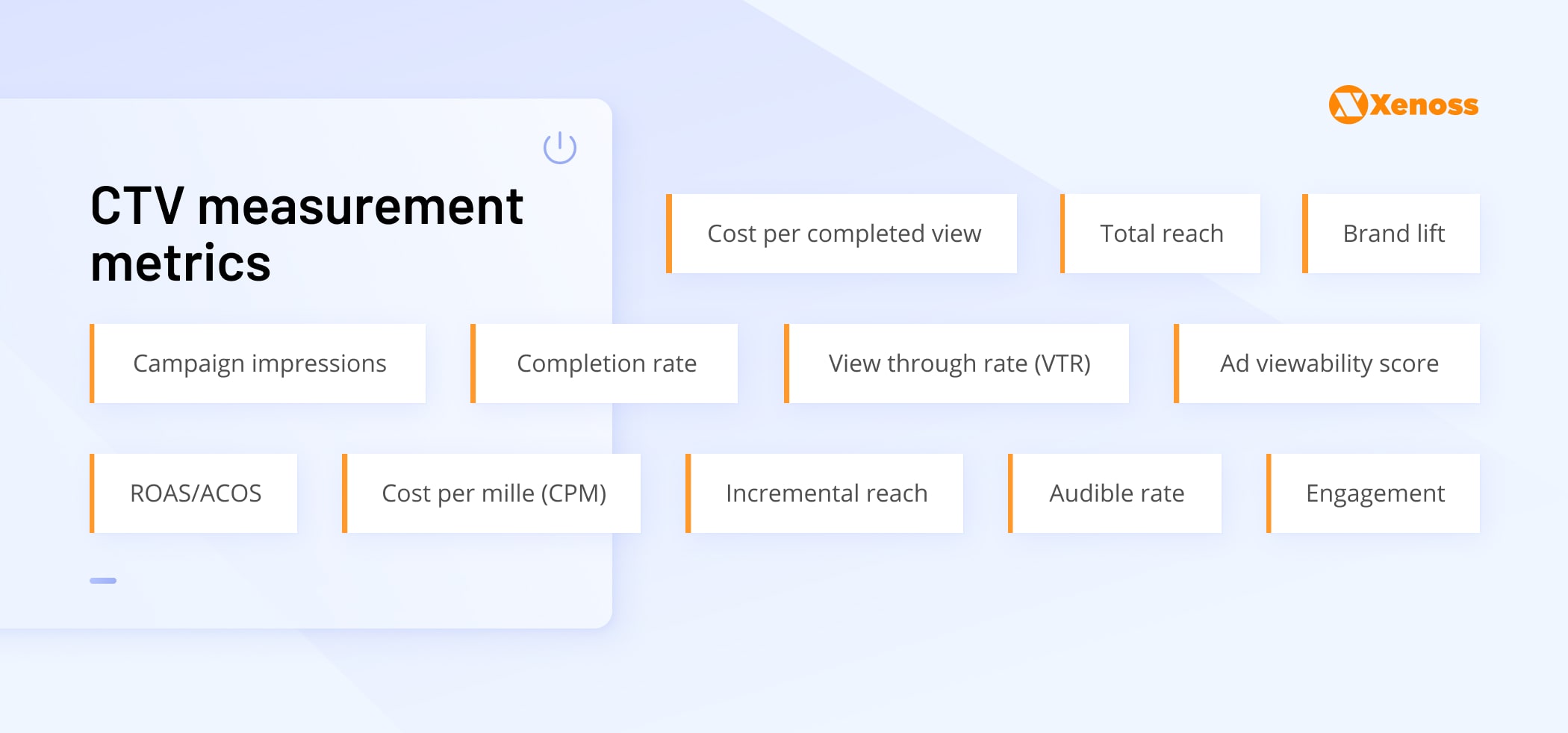
Buyers want both familiar linear TV metrics and programmatic ones. Yet, many DSPs and SSPs struggle to deliver such a large roster of accurate insights. So brands are eager to test multiple CTV attribution options on the table. The Trade Desk, Verizon Media, and Viant Technology already went with iSpot. Xandr, ABEMA, Smadex, and tvScientific have selected Adjust.
Why do brands want multiple partners? Because the “big four” CTV platforms (Samsung, Roku, Amazon, and Google) employ proprietary approaches to measurement (which they don’t fully disclose). There’s no neutral entity like Nielsen to verify their claims.
Also, fragmentation exists on the AdTech level, where buyers can purchase CTV ads via different ad networks or from CTV/OTT platforms directly. This further splinters audience data and complicates measurement.
Complex device identification process
Since most platforms rely on IP addresses for user identification, it’s hard to determine who saw the ad: the same person on two different devices, multiple people on one device, or multiple people via the same OTT app.
Also, CTV/OTT ads rely on the server-side ad insertion (SSAI) mechanism. It seamlessly integrates ad videos into the streamed content. SSAI is resistant to ad blockers and allows low-latency ad serving. However, SSAI needs accurate device ID data to deliver accurate impression counts.
In 2019, IAB released guidelines for identifying CTV/OTT devices and apps. However, these guidelines aren’t comprehensive. For example, not all platforms can supply “app store IDs” to ad networks.
Using WURFL device detection database is one workaround. It streamlines user device identification (device model, browser, OS, screen width, etc.). WURFL can be used to improve CTV attribution when paired with machine learning. Still, the setup process is quite complex.
Cross-media measurement
Market fragmentation means that consumers have a lot of choices. Naturally, most switch between watching linear TV, using CTV apps, and OTT services on mobile.
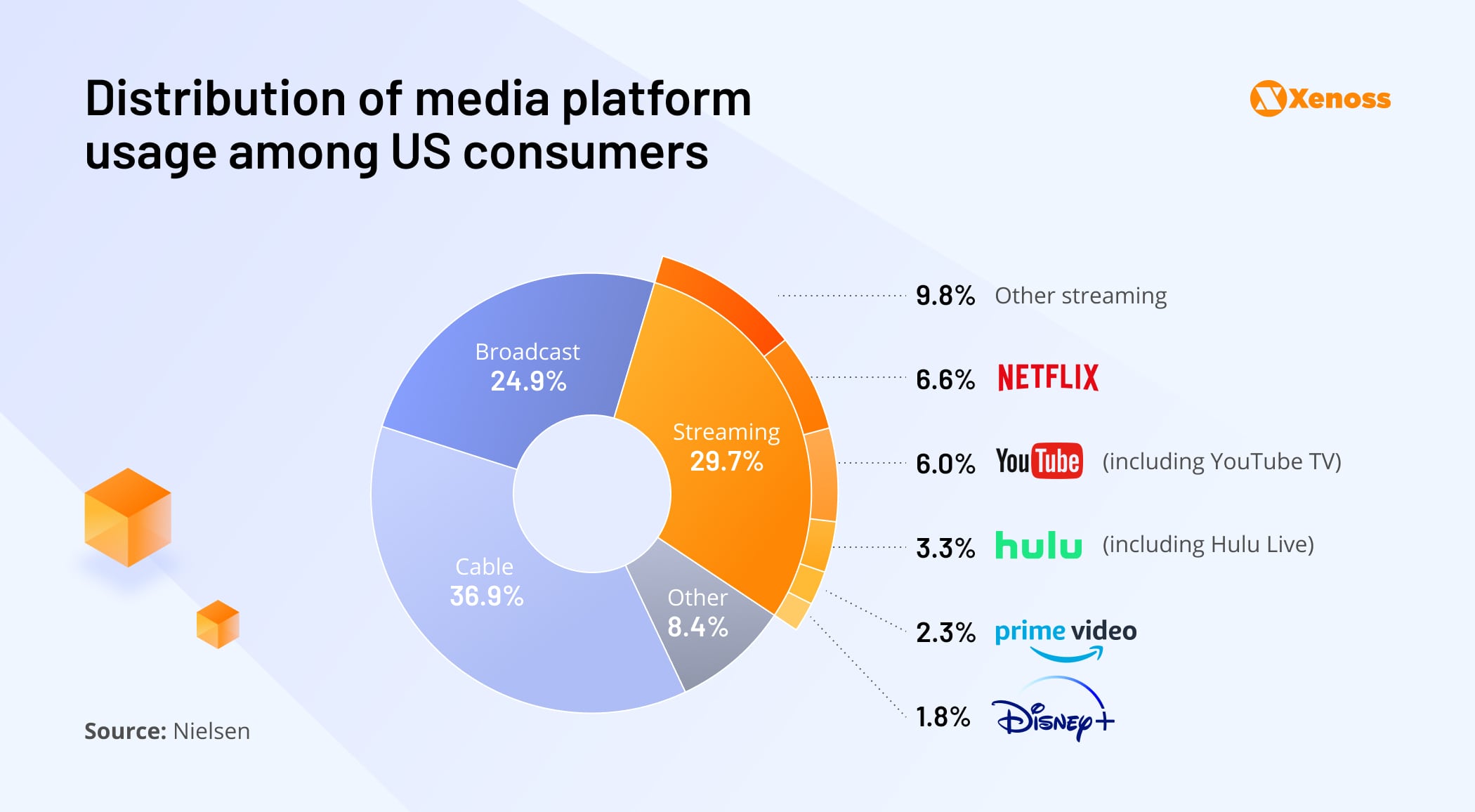
The wrinkle? Few exchange data with one another. Audience data is siloed between:
- Digital multichannel video programming distributors (MVPDs)
- Direct-to-consumer OTT apps
- Smart TV manufacturers
- CTV OS distributors
- SSPs, DSPs, and ad networks
As a result, procuring data points such as device ID, audience demographic, or average viewership is hard, even for original content owners. Distributors typically hold most of the data to attract demand, though some publishers now buy back audience insights. Getting a consolidated view of video content viewership rates is somewhat problematic.
CTV advertising fraud
Programmatic ad fraud is a gruesome industry issue. CTV ads are no exception.
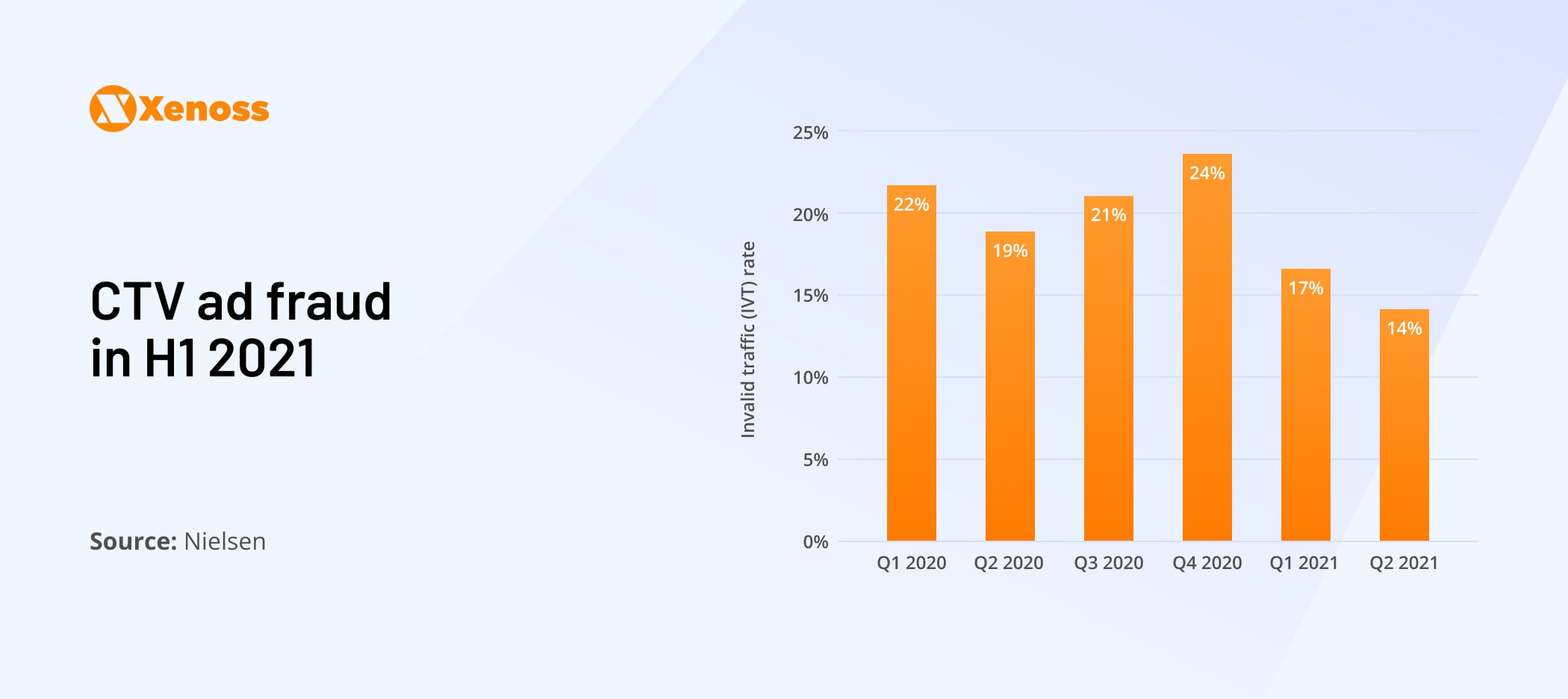
Complex attribution stands behind high IVT rates in CTV advertising. Because verified data is hard to produce, faking ad impressions for CTV is easier than for desktop or mobile devices (although sophisticated ad fraud detection mechanisms might help).
Organizations like IAB Open Measurement, Media Rating Council (MRC), Trustworthy Accountability Group (TAG), and Brand Safety Institute have released comprehensive CTV ad fraud prevention guidelines. The challenge, however, lies in implementing them.
[cta-with-description title=”Looking to enhance your CTV ad solution? ” description=”Consult Xenoss tech experts to determine the optimal stack for your product. ” url=”https://xenoss.io/ctv-ott-advertising-platform-development” buttontext=”Contact us”]
6 best practices of CTV measurement
No single metric can indicate the success of a CTV ad campaign. To reassure the buy-side, AdTech players have to provide a roster of cross-channel metrics, proving ad validity and viewability.
Of course, the best industry minds are working on the CTV measurement problem. In Q3 2022, IAB released a CTV version of Open Measurement SDK (OM SDK). IAB Tech Lab plan to make it a common framework for interoperability:
OM SDK gives advertisers flexibility and choice in the verification solutions from their preferred providers by making it easier for publishers to integrate one SDK and enable ad verification with all verification vendors.
OM SDK is a helpful tool but not a stand-alone solution. To improve CTV measurement, you need to combine several best practices.
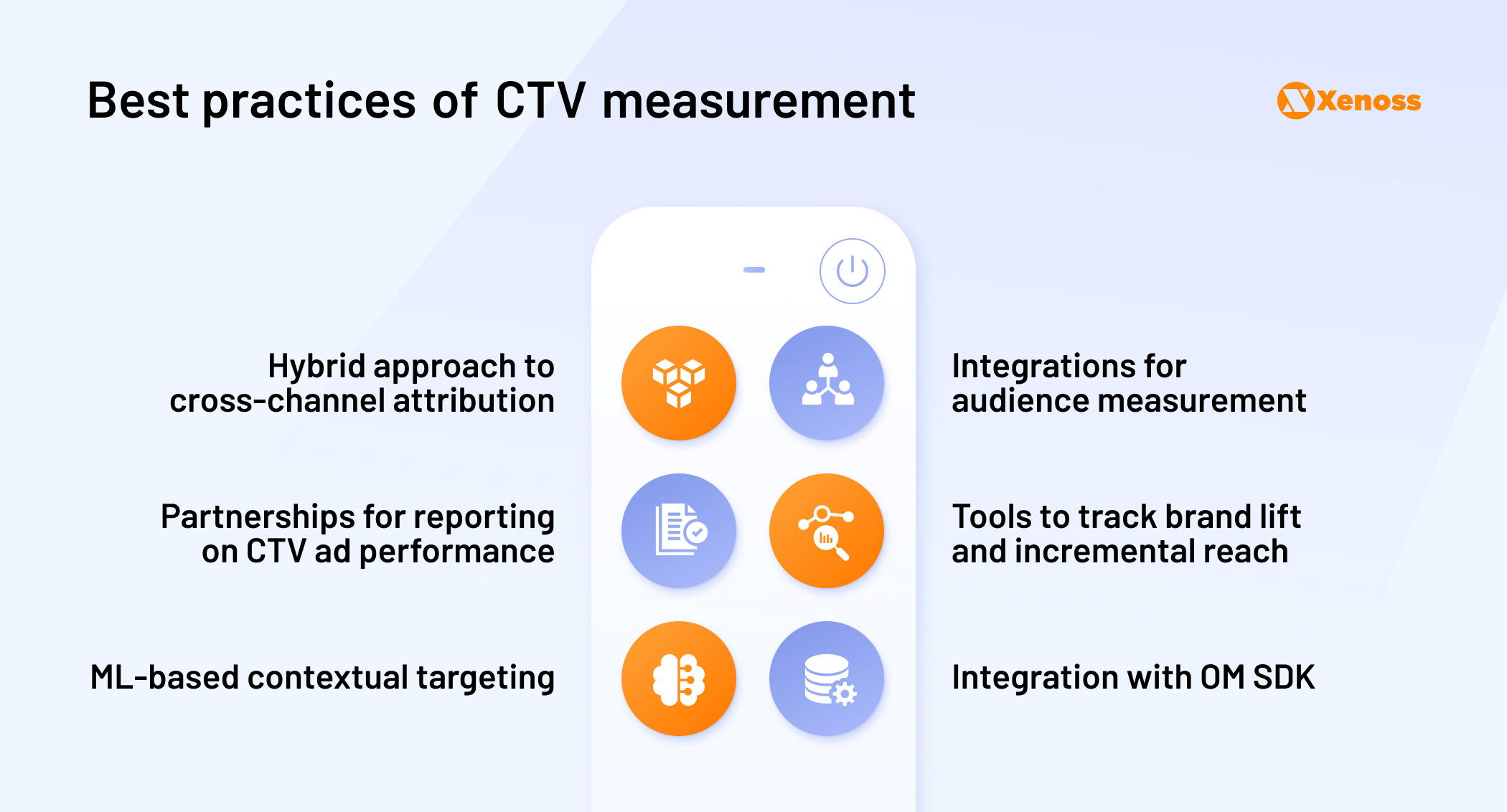
Employ a hybrid approach to cross-channel attribution
Because access to audience data is constrained, no best-of-breed user attribution solution is available. Instead, the industry tests various methods for identifying users and tracking their interactions with content.
IAB suggests that the path pass forward would be using hybrid measurement approaches that combine:
- Automatic content recognition (ACR) methods such as audio fingerprinting or watermarking
- Passive panel metering technologies such as people meters
- Digital metering using linked mobile devices or home router level meters
- Third- or first-party census feeds
The combination of these signals can enable industry players to minimize ad duplication and better distinguish between linear TV, CTV app feeds at the household and individual levels, and broadcast video on demand (BVOD).
Separately, user ID data such as identifiers for advertising (IFAs), CTV IDs, device IDs, and IP addresses could be cross-matched with audience profiles across platforms. In fact, most market players are making strides in this direction.
Verizon Media ID
Verizon Media ConnectID already includes CTV household data. In 2021, Verizon Media also partnered with smart TV manufacturer VIZIO to gain even more viewership data from some 18 million VIZIO Smart TVs devices. The partnership enables Verizon Media to offer expanded CTV targeting, optimization, and measurement opportunities for their DSP advertisers.
Roku Advertising Watermark
At the beginning of 2022, Roku released Advertising Watermark – a platform-native way to validate video ads’ authenticity on the Roku platform. Publishers can use Roku ad measurement beacons to bot mitigation platforms like HUMAN and third-party ad measurement platforms to verify that their ads were generated by Roku devices. This mechanism prevents device spoofing. Discovery and FOX are already among Roku’s Advertising Watermark adopters. Also, the watermark is embedded into Roku’s ad buying platform, OneView.
Determine the optimal approach to audience measurement
Since CTV is a cookieless environment, precise audience measurement is complex but possible. Media Rating Council (MRC) has an exhaustive list of standards and approaches to cross-media CTV audience measurement.
In short, there are two main options:
- pixel-based technology to capture an impression, video start, and completion data; and to detect and report on Invalid Traffic.
- embedded SDK or client-side measurement code for cross-channel measurement (such as OM SDK by IAB).
Once again, leaders don’t settle for one option. Most establish extensive audience measurement with Automatic Content Recognition (ACR) technologies.
ACR matches individual objects in a video with database records to identify and recognize streaming content. The technology includes either or both video pixel detection (video fingerprinting) and audio capture (acoustic fingerprinting).
ACR-supported devices (smart TVs, smartphones, and tablets) allow ad networks to capture these data points:
- Platform type – linear, CTV, MVPD, or another VOD service
- Geo-location data
- IP address
- Demographics data
- Viewing behaviors – average watch time, ad competition rates, channel surfing parameters, etc.
Tech-wise, ACR algorithms generate library-side fingerprints for the publisher’s media. Fingerprints are designed to compare sample video/audio content against references in the publisher’s database to identify the played content. When a viewer browses content via an ACR device, they generate extra fingerprints, which then get matched to stored records.
Based on matches, AdTech platforms access the above data for targeting, measurement, and attribution. Next, ACR data can be cross-validated with passive or digital metering for even higher accuracy.
iSpot audience measurement with ACR
iSpot developed a robust cross-channel TV measurement tech suite for detecting ACR-sourced ad impressions across 51+ million smart TVs and some 155 networks across the US. The platform relies on intelligent algorithms for matching impression counts against set-top box data and a person-level panel for extra precision. Separately, ad impressions are verified manually by a team of editors.
Such a comprehensive TV ad measurement stack made iSpot the biggest challenger to Nielsen. Its publishing partners already include NBCUniversal, Samba TV, and Crackle Plus, among others. On the AdTech side, iSpot secured deals with The Trade Desk, Verizon Media, and Google Ads, among others.
Figure out how to best report on CTV ad performance
Brands can track connected TV ads using standard performance metrics like ad viewability, quartile rates, and completion rates. However, these don’t always provide an accurate picture.
Ad verification firm DoubleVerify found that one in four CTV platforms continued playing content, including recorded ad impressions, after the TV set was turned off. Ouch, this better get fixed — and it likely will be.
In June 2022, GroupM launched an initiative to cocreate a streamlined measurement framework and best practices for verifying that ads only get served when CTV screens are on. Companies, including Disney, LG Ads Solutions, NBCUniversal, Paramount, VIZIO, Warner Bros, Discovery, and Fox/Tubi, are already on board.
Double Verify, in turn, chimed in with a Fully On-Screen certification. Accredited by the Media Rating Council, Fully On-Screen ensures that ads are only displayed when the TV screen is turned on, and content is fully on-screen.
IAB also recommends using the cost-per-completed viewable view (CPCVV) metric since it’s the most efficient and value-driven option.
Provide tools to track brand lift and incremental reach
Most advertisers choose CTV to improve ToFU metrics like brand awareness and consideration. Also, they want to understand how many unique audiences OTT video campaigns engage on top of linear TV campaigns.
Respectively, buyers want to see brand lift and incremental reach stats in their dashboards. In CTV/OTT advertising platform development, you have several ways to deliver these stats.
Brand lift tracking options:
- Partner with CTV/OTT providers and/or third-party measurement companies to access intel.
- Employ statistical modeling methods to estimate CTV ad exposure.
- Augment extrapolated data with passive exposure tracking panels such as mobile metering and fingerprinting technologies.
- Issue in-device surveys to capture viewers’ sentiment towards promoted brands.
Incremental reach tracking
- Use ACR technology (audio or acoustic fingerprinting) to identify consumed content and viewing patterns.
- Add a passive metering device to capture audio watermarks for higher precision.
- Combine ACR data with device graphs to better distinguish between users who saw linear vs. OTT campaigns (and vice versa). This tech combo can also help retarget exposed users with a sequential campaign across channels, plus re-optimize display frequency.
Consider ML-based contextual targeting as an add-on
ACR is a firmware-based solution. ML-based contextual targeting is a conceptually similar solution but on a software level. This option might be better suited for AdTech companies that don’t want to source ACR data from multiple CTV platforms.
Apart from monitoring user behaviors similar to ACR, ML-based contextual targeting systems can:
- Forecast advertising inventory volumes across networks
- Model accurate campaign performance predictions
- Facilitate audience segmentation and data-driven audience modeling
- Promote better CTV ad fraud detection and prevention
- Improve user/device identification and ad measurement tracking
Combined, these qualities make ML based contextual targeting a competitive add-on for your ad network.
Integrate a third-party CTV ad measurement SDK
At the end of the day, brands want guarantees. Many CTV platforms have already voiced their support for OM SDK:
- Apple TV
- Amazon Fire
- Android TV (Google TV)
What about the remaining options like Roku, Samsung Tizen, LG Web OS, and others? If you work with those providers, you’ll have to build a custom SDK for integrating third-party measurement partners. You can turn to professional tech consultants like Xenoss to build a custom SDK for integration and resolve other challenges of the CTV/OTT advertising platform development.
Final thoughts
Connected TV advertising is still a “Wild West” for AdTech providers. Some chose to go “cowboy style” and accelerate their entry into this environment without having CTV ad measurement and attribution tools. This tactic might have worked a couple of years back, but in today’s swiftly maturing CTV landscape, vendors that cannot send a wealth of data down the bid stream will soon turn obsolete.
As CTV platforms continue to compete with one another for ad dollars, smarter AdTech players can focus on developing better CTV measurement solutions to fit into this nascent ecosystem.
Want to be at the vanguard of CTV ad measurement? Xenoss can help you get there with our in-depth AdTech market expertise and technical know-how. Contact us to discuss your project.

